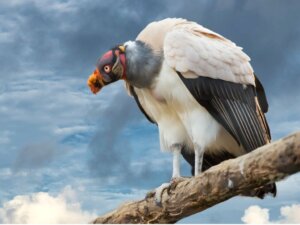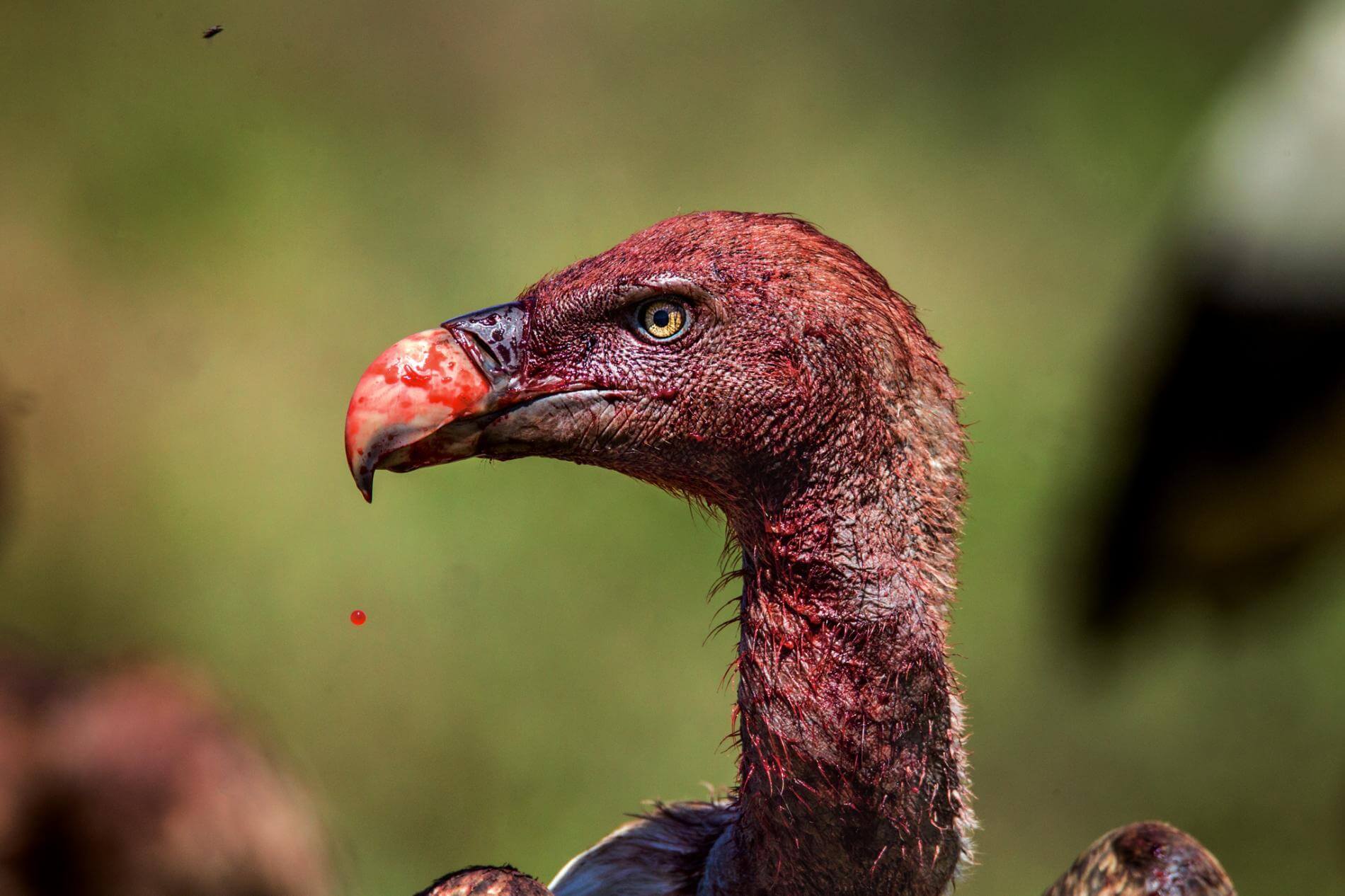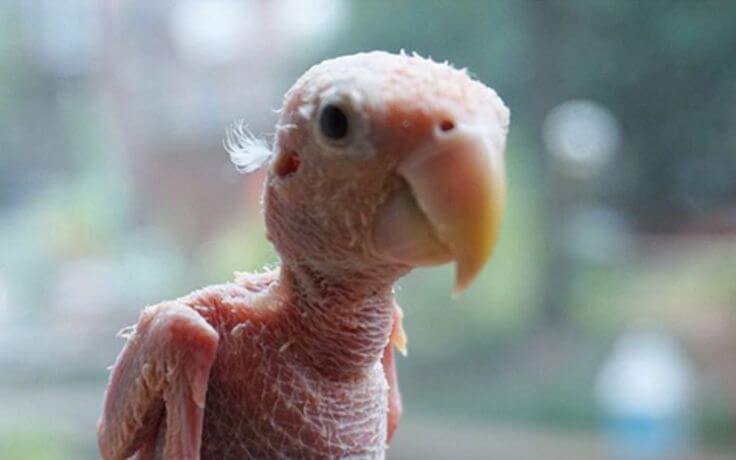Do Featherless Birds Exist?


Written and verified by the biologist Raquel Rubio Sotos
Birds’ feathers are their great distinguishing feature, and are unique to these animals. They’re an epidermal structure that helps to maintain temperature, carry out courtship, and protect them against predators, as well as allowing them to transport themselves both in the air and in the water. So, today we ask the question: do featherless birds exist?
Depending on the area of the bird and whether they’re flying or not, there are different types of feathers. On the one hand, we have covering feathers, such as down, which have a thermoregulatory function. For flight, they use the primary and secondary feathers of the wings, and the tail feathers.
Seeing how important feathers are for birds, do featherless birds exist? To find out the answer, read on.
Do featherless birds exist?
As we have already seen, feathers are a distinctive and unique characteristic of birds. They’re structures composed of keratin and can be divided into several parts. On the one hand, we have the rachis which is the rigid part of the feathers, and when it is in contact with the skin it widens and is called the calamus. The other part of the feathers is the vexillum, which are wattles that grow on the sides of the rachis.
Birds’ feathers form an intricate network that allows them to support a high load, and this allows them to fly. In order to maintain a perfect plumage, birds perform meticulous grooming. In most birds, with the exception of penguins, the feathers grow in an area of the body called pterylae, surrounded in turn by bare areas called apteria.
As to whether featherless birds exist, in adulthood and under normal conditions, all birds have feathers. However, there are birds that have certain parts of the body devoid of feathers such as the head, in some areas used for courtship and in incubation patches located in the ventral area.
Vultures (order Cathartiformes)
As a general rule, most vultures are scavengers and tend to be featherless birds in the head and neck area. This is related to the type of feeding they do.
To eat from the carcasses, vultures stick their heads into different orifices, from those already opened up by other predators, to the animal’s own orifices, such as the anus and rectum. This causes the head and neck to be filled with blood, fecal matter, and bacteria.
The lack of feathers in these areas allows them to more easily maintain hygiene in this area, thus avoiding disease and also improving mobility when entering the carcass.

Turkeys (family Phasianida)
Turkeys are birds without feathers in the head and neck area. The courtship factor may be one of the main causes of this phenomenon. Although male and female turkeys have no plumage in that area, the male has many caruncles.
Caruncles are protrusions on the neck and head, the larger and more colorful they are, and the more attractive they are to females. In addition, it’s also believed to be an adaptation to avoid the heat of the environment.
A study in the journal Plos Biology, has found that the special metabolization process of vitamin A that these birds possess creates a protein that prevents the growth of feathers in the areas of the head and neck.
Kiwi (Apteryx)
The kiwi belongs to the genus Apteryx, which is the same as ostriches and emus. They’re iconic birds in New Zealand – flightless and with virtually no wing growth. At first glance, they look like featherless birds, as what they have is down that can be confused with hard hair. Their feathers didn’t fully develop due to adaptations to the climate.
Magnificent frigatebird (Fregata magnificens)
Frigatebirds are seabirds. In this case, the species Fregata magnificens, is characterized by its courtship. These birds have an area devoid of feathers in the crop area. Instead, they have a bright red gular pouch, which swells during breeding periods to attract females.
Bare-faced bulbul (Pycnonotus hualon)
The bare-faced bulbul (Pycnonotus hualon), is a bird endemic to Laos, characterized by having no feathers on its face. It was discovered in 2009 and there’s little information about it at the moment. It stands out for its song.
Featherless birds for various reasons
In cases of featherless birds which normally have feathers, it may be caused by other factors, both ethological and medical. Here are some examples.
Pathogenic germs
There are many pathogens that can cause birds to be featherless. One of the best-known diseases is Polyomavirus, which mainly affects budgerigars. One of the symptoms it generates is the appearance of red petechiae together with the fall of the plumage. In addition, it’s associated with loss of appetite and depression, and is often fatal.
Another disease that causes feather loss is beak and feather disease. It usually affects only psittacines and is often fatal. This disease affects the birds’ immune system and is highly contagious. If it occurs acutely, apart from digestive problems, feather loss occurs, along with pain in the area.
When it’s a chronic case, affected birds can live with the disease for several years. In this case, the feathers become brittle, fractured, discolored, curled, and deformed. Because it affects the feather follicles, once the feathers fall out they’re unable to replace them.
Behavioral disorders
One of the main causes of feather loss in birds is stress. Preening in birds is normal and necessary for the correct positioning of feathers and their hygiene, but when it turns into a compulsive attitude or stereotypy, we talk about pecking.
Normally, pecking starts in a small and localized area, but if it isn’t detected in time or if this behavior isn’t stopped, it can lead to self-mutilation in the affected individuals.
When pecking is detected in birds it’s important to find the possible cause that generates it. In this case, there are three main causes:
- Organic: These are related to health problems in the bird, whether external parasites such as mites and lice, internal parasites, incorrect feeding that leads to malnutrition, allergies, and viruses or pathogens such as those we saw earlier.
- Environmental: Inadequate light conditions, humidity, temperature, environmental irritants (tobacco, fumes), incorrect positioning of their cage, a lack of food, and no stimuli can all cause stress and boredom that lead to pecking.
- Behavioral: This occurs only in captive birds. Situations of hyper-attachment to the owners, a lack of company and environmental enrichment, and fears and phobias can all lead to an obsessive-compulsive disorder such as pecking.
Ideally, you should detect the problem as soon as possible and contact an expert, so that this behavior can be resolved as quickly and effectively as possible.
Follicular cyst
This is a problem – usually congenital – which occurs more frequently in birds with a high density of feathers, such as parrots and canaries.
The cysts originate when the feather is unable to penetrate the epidermis and grows inwardly, causing a lump to appear. To remove these cysts, surgery is necessary, usually by electric scalpel, as there’s currently no other treatment.
Plumage development abnormalities
One way to easily see if there are abnormalities in feather development is by observing the molt pattern of the birds and the color of the feathers. Under normal conditions, birds molt three times a year, with the exception of certain birds, such as penguins. If birds molt constantly, it means that something is wrong.
When molting is almost constant, it’s usually caused by inappropriate temperatures for the individuals concerned. The plumage helps to thermoregulate the birds’ temperature, and, if it’s too hot, they’ll be constantly shedding feathers, which can lead to weakness and serious health problems.
Another way to detect an abnormality in feather development is through their coloration. Normally, feathers are brightly colored. When either the brightness or the color changes, it’s usually associated with a poor diet, with little variety, and poor in nutrients, which creates problems in their development.
Chrysanthemum disease
This is a genetic and congenital disease that stops feather growth. Birds with this condition have serious problems in regulating their body temperature, so they must be kept in optimal conditions at all times to avoid ailments and physiological problems.
Altricial broods
In nature, there are two types of young in birds. On the one hand, we have nestlings, which have open eyes and dense down as soon as they’re born. This is common in ducks, moorhens, and pheasants. This allows the young to get their own food and walk shortly after birth.
Altricial young are those that are born helpless, featherless, and with their eyes closed. In this case, the parents are in charge of feeding and caring for them until they gradually develop feathers and leave the nest. In this case, these featherless birds are naturally like this until they fully develop.

So, here are some cases of featherless birds. If you have a bird that shows any symptoms or strange behavior, then taking it to an expert in the shortest possible time can help you quickly find the cause(s) of this feather loss, and the stress that this brings to the bird.
All cited sources were thoroughly reviewed by our team to ensure their quality, reliability, currency, and validity. The bibliography of this article was considered reliable and of academic or scientific accuracy.
- Senar, J. C., & Guallar, S. (2004). Mucho más que plumas (Vol. 2). Barcelona: Institut de Cultura de Barcelona.
- Información obtenida el día 08/07/2021 en el siguiente enlace: https://www.europapress.es/ciencia/laboratorio/noticia-desvelan-origen-genetico-cuello-desplumado-algunas-aves-20110315233037.html
- Ramis, A., Latimer, K. S., Niagro, F. D., Campagnoli, R. P., Ritchie, B. W., & Pesti, D. (1994). Diagnosis of psittacine beak and feather disease (PBFD) viral infection, avian polyomavirus infection, adenovirus infection and herpesvirus infection in psittacine tissues using DNA in situ hybridization. Avian Pathology, 23(4), 643-657.
This text is provided for informational purposes only and does not replace consultation with a professional. If in doubt, consult your specialist.